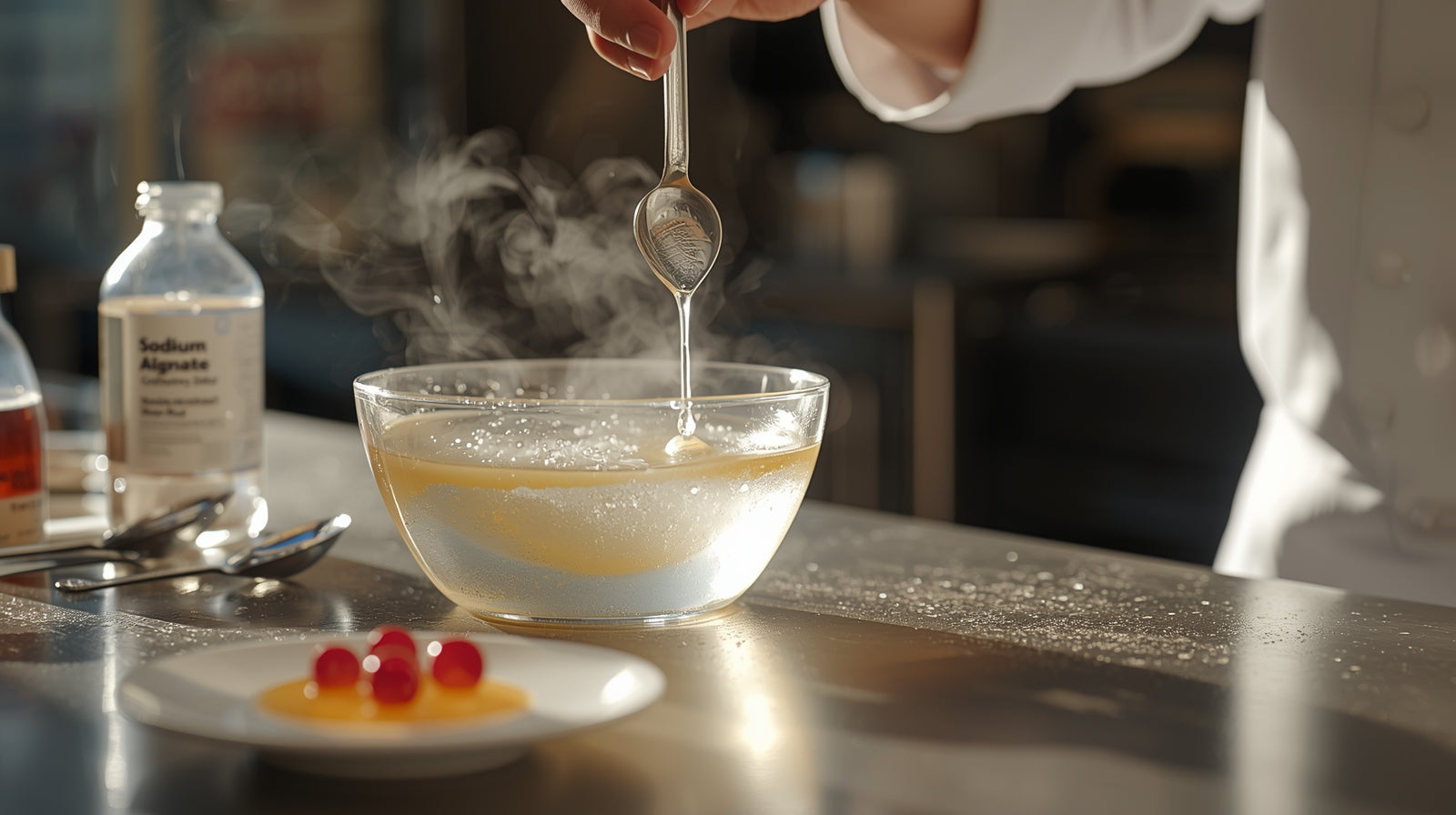
Sodium Alginate in Food Applications: Exploring Its Versatile Functions and Culinary Uses
SUBSCRIBE TO OUR BLOG
Promotions, new products, and recipes.
-
The core functions of sodium alginate in food—thickening, gelling, stabilizing, and modifying texture
-
How sodium alginate is used across various culinary applications, from sauces and dressings to molecular gastronomy
-
What to consider when selecting high-quality food-grade sodium alginate, including purity and brand reliability
-
Practical tips for using sodium alginate at home and how it can enhance both traditional and modernist recipes
Sodium Alginate in Food Applications: Exploring Its Versatile Functions and Culinary Uses
Sodium alginate is a natural ingredient that's becoming more popular in kitchens. It's used by both professionals and home cooks because of its special qualities.
It's known for its versatility and ability to improve food. The significance of high-quality sodium alginate in the food industry is its ability to add texture and stability to different products.
Let's look into the functions and uses of best sodium alginate. We'll see how it's used and why it's a key ingredient in many kitchens.
Key Takeaways
- Sodium alginate is a versatile ingredient used in various food applications.
- It provides texture and stability to food products.
- Sodium alginate is derived from natural sources.
- Its unique properties make it a favorite among chefs and food manufacturers.
- The use of sodium alginate enhances culinary creations.
What is Sodium Alginate? Understanding the Food Industry's Versatile Ingredient
Sodium alginate is a natural substance used in food for its benefits. It comes from brown seaweed and is key in many products. Learn more about its scientific background.
Origin and Natural Sources
Sodium alginate comes from brown seaweed found in the world's coasts. The main sources are Macrocystis pyrifera and Ascophyllum nodosum.
Chemical Properties and Food Safety Profile
Sodium alginate can thicken liquids and form gels. It's safe for food, approved by the FDA and other global bodies. You can also find it in Cape Crystal’s powder form.
Why Chefs and Food Manufacturers Value This Ingredient
Chefs and makers like sodium alginate for its texture and stability. It's used in desserts and sauces. Its natural origin and function make it a top choice.
| Property | Description |
|---|---|
| Origin | Derived from brown seaweed |
| Chemical Function | Thickening, gelling, and stabilizing |
| Safety Profile | Recognized as safe by global regulatory bodies |
Key Functions of Sodium Alginate in Food Processing
Sodium alginate is key in food processing. It makes food textures better and more stable. It's used in many foods, like desserts, sauces, and drinks.
Thickening and Gelling Properties
Sodium alginate is great at thickening and gelling. It turns into a gel when mixed with calcium. This is perfect for puddings and jellies. It’s also central to spherification techniques.
Stabilizing Emulsions and Suspensions
Sodium alginate is also good at keeping ingredients together. It stops them from separating. This is important for dressings and drinks.
Texture Modification Capabilities
Sodium alginate can change the texture of food. It can make things soft and chewy or firm and gel-like. Chefs and food makers love it for this reason.
| Function | Application | Benefit |
|---|---|---|
| Thickening and Gelling | Desserts, Sauces, Dressings | Achieves desired consistency and texture |
| Stabilizing Emulsions and Suspensions | Salad Dressings, Beverages, Dairy Alternatives | Prevents ingredient separation, ensures homogeneity |
| Texture Modification | Various Food Products | Creates diverse textures, enhances product innovation |
Selecting the Best Sodium Alginate for Your Culinary Needs
Sodium alginate is a versatile ingredient, but choosing the right one is key. Whether you're a chef or a cooking enthusiast, knowing the different types is important. It helps you get the best results in your recipes.
Food-Grade vs. Industrial-Grade Products
It's important to know the difference between food-grade and industrial-grade sodium alginate. For culinary use, always choose food-grade products.
Purity Levels and Their Importance
The purity of sodium alginate affects its performance. High-purity sodium alginate gives you consistent texture and flavor. Choose products with few impurities for the best results.
Top Brands and Their Specific Applications
Many trusted brands offer quality sodium alginate. Kimica and FMC BioPolymer are favorites among chefs and food makers. Each brand is suited for different uses, so pick the right one for your needs.
Storage and Shelf Life Considerations
Keeping sodium alginate in good condition is important. Store it in a cool, dry place, away from sunlight. Learn more in our comparison of wall materials.
Creative Culinary Applications and Techniques
Sodium alginate has changed the culinary world. It's not just for food makers. Chefs and home cooks love it for new recipes.
Molecular Gastronomy: Spherification and Beyond
Molecular gastronomy is big, and sodium alginate leads the way. It's famous for spherification. This turns liquid into bursting spheres. You can try it with our Direct Spherification Kit.
Modernist Cuisine Recipes Using Sodium Alginate
In modernist cuisine, sodium alginate makes amazing dishes. You can find everything from alginate ravioli to desserts. Browse ideas in our kit variations.
Home Kitchen Applications and Beginner Tips
Starting with simple recipes is best for beginners. Try making desserts or thickening soups with alginate-based ingredients. Always follow the right amounts and steps. Or, get inspired by this hydrogel research article.
Conclusion: Embracing Sodium Alginate in Modern Cuisine
Sodium alginate has changed the way we cook, making food more exciting. It's great for thickening, gelling, and stabilizing mixtures. This makes it a key ingredient in both professional and home cooking.
It lets chefs and home cooks create new textures and dishes. Whether you're experienced or just starting, sodium alginate can take your cooking to the next level.
Knowing about different types of sodium alginate and how to store it is important. This knowledge helps you use it to its fullest. Try sodium alginate in your cooking and see what amazing dishes you can make.
FAQ
What is sodium alginate, and where does it come from?
Sodium alginate comes from brown seaweed. It's used in food because of its special properties.
Is sodium alginate safe to consume?
Yes, it's safe to eat. It meets food safety standards and is approved for use in food.
What are the key functions of sodium alginate in food processing?
Sodium alginate thickens, gels, and stabilizes food. It also changes texture. These uses make it valuable in many foods.
How do I choose the right sodium alginate for my needs?
Look at the grade, purity, and use. Check out top brands and their suggestions to help choose.
Can I use sodium alginate in home cooking, and how do I get started?
Yes, you can use it at home. Learn about its uses and try simple recipes. Start small and be patient.
What is spherification, and how is sodium alginate used in this technique?
Spherification makes food into small spheres. Sodium alginate is mixed with calcium chloride to create these spheres.
How should I store sodium alginate to maintain its quality?
Keep it cool, dry, and away from sunlight and moisture. This helps it last longer.

|
About the Author Ed is the founder of Cape Crystal Brands, editor of the Beginner’s Guide to Hydrocolloids, and a passionate advocate for making food science accessible to all. Discover premium ingredients, expert resources, and free formulation tools at capecrystalbrands.com/tools. — Ed |
Enjoyed this post? Subscribe to The Crystal Scoop
Food-science tips, ingredient know-how, and recipes. No spam—unsubscribe anytime.
- Choosing a selection results in a full page refresh.



